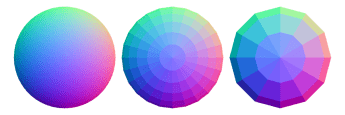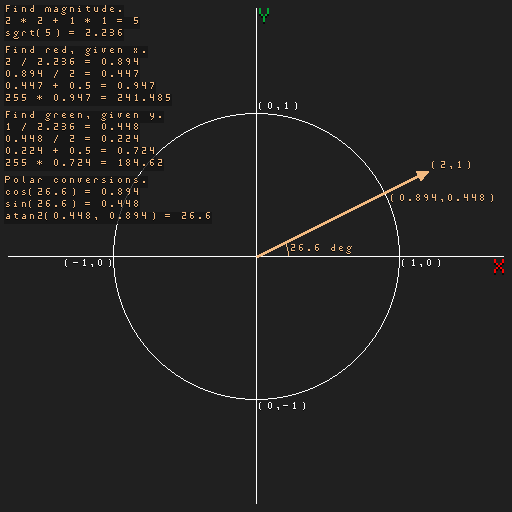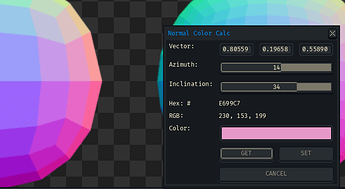Hi @D_W,
If it helps you to imagine that you’re looking down at a sphere’s North pole, I suggest comparing Aseprite’s normal map wheel with others online first. Maybe bring them in as a reference image or drag and drop two sprite tabs.
For example, this is an image looking down at 3 UV spheres that I made in Blender.
If the distribution of discrete swatches matters, icospheres or cube-spheres could be used instead.
I realize my eyedropper can’t be seen in the comparison below, so I encourage you to do your own comparison (using both smooth and discrete images).
If knowing some of the math behind the colors would help, here’s a diagram simplified from 3D to 2D. This is for the vector (2, 1).
This should look familiar if you’ve taken a trigonometry class. A fuller 3D maths detail can be found in an entry on the spherical coordinate system. (3D coordinate systems vary across game engines and software; see the right-hand rule.)
The math can be parlayed into a Lua color picker script. My preference would be to work in directions instead of trying to combine colors directly.
This script will calculate directions below an inclination of zero (at a normal sphere’s equator), though they are not used in normal maps.
local function fromSpherical(az, incl)
local a = az * math.pi / 180.0
local i = incl * math.pi / 180.0
local cosAzim = math.cos(a)
local sinAzim = math.sin(a)
local cosIncl = math.cos(i)
local sinIncl = math.sin(i)
return cosIncl * cosAzim,
cosIncl * sinAzim,
sinIncl
end
local function toSpherical(x, y, z)
local sqmag = x * x + y * y + z * z
if sqmag > 0.0 then
local azRad = math.atan(y, x)
local azDeg = azRad * 180.0 / math.pi
local inclRad = math.acos(z / math.sqrt(sqmag))
local inclDeg = inclRad * 180.0 / math.pi
inclDeg = 90.0 - inclDeg
return azDeg, inclDeg
else
return 0.0, 90.0
end
end
local function vecToColor(x, y, z)
local sqMag = x * x + y * y + z * z
if sqMag > 0.0 then
local mag = math.sqrt(sqMag)
local xn = x / mag
local yn = y / mag
local zn = z / mag
local r01 = xn * 0.5 + 0.5
local g01 = yn * 0.5 + 0.5
local b01 = zn * 0.5 + 0.5
local r255 = math.tointeger(0.5 + 255.0 * r01)
local g255 = math.tointeger(0.5 + 255.0 * g01)
local b255 = math.tointeger(0.5 + 255.0 * b01)
return Color(r255, g255, b255, 255)
else
return Color(128, 128, 255, 255)
end
end
local function updateWidgetClr(dialog, clr)
dialog:modify {
id = "normalColor",
colors = { clr } }
dialog:modify {
id = "hexCode",
text = string.format(
"%06X",
(clr.red << 0x10 |
clr.green << 0x08 |
clr.blue))
}
dialog:modify {
id = "rgbLabel",
text = string.format(
"%d, %d, %d",
clr.red,
clr.green,
clr.blue)
}
end
local function updateWidgetCart(dialog)
local args = dialog.data
local x = args.x
local y = args.y
local z = args.z
local a, i = toSpherical(x, y, z)
if a < 0.0 then a = a - 0.5 end
if a > 0.0 then a = a + 0.5 end
if i < 0.0 then i = i - 0.5 end
if i > 0.0 then i = i + 0.5 end
dialog:modify {
id = "azimuth",
value = math.tointeger(a)
}
dialog:modify {
id = "inclination",
value = math.tointeger(i)
}
local clr = vecToColor(x, y, z)
updateWidgetClr(dialog, clr)
end
local function updateWidgetSphere(dialog)
local args = dialog.data
local az = args.azimuth
local incl = args.inclination
local x, y, z = fromSpherical(az, incl)
dialog:modify { id = "x", text = string.format("%.5f", x) }
dialog:modify { id = "y", text = string.format("%.5f", y) }
dialog:modify { id = "z", text = string.format("%.5f", z) }
local clr = vecToColor(x, y, z)
updateWidgetClr(dialog, clr)
end
local dlg = Dialog { title = "Normal Color Calc" }
dlg:newrow { always = false }
dlg:number {
id = "x",
label = "Vector:",
text = string.format("%.5f", 0.0),
decimals = 5,
onchange = function()
updateWidgetCart(dlg)
end
}
dlg:number {
id = "y",
text = string.format("%.5f", 0.0),
decimals = 5,
onchange = function()
updateWidgetCart(dlg)
end
}
dlg:number {
id = "z",
text = string.format("%.5f", 1.0),
decimals = 5,
onchange = function()
updateWidgetCart(dlg)
end
}
dlg:newrow { always = false }
dlg:slider {
id = "azimuth",
label = "Azimuth:",
min = -180,
max = 180,
value = 0,
onchange = function()
updateWidgetSphere(dlg)
end
}
dlg:newrow { always = false }
dlg:slider {
id = "inclination",
label = "Inclination:",
min = -90,
max = 90,
value = 90,
onchange = function()
updateWidgetSphere(dlg)
end
}
dlg:newrow { always = false }
dlg: label {
id = "hexCode",
label = "Hex: #",
text = "8080FF"
}
dlg:newrow { always = false }
dlg: label {
id = "rgbLabel",
label = "RGB:",
text = "128, 128, 255"
}
dlg:newrow { always = false }
dlg:shades {
id = "normalColor",
label = "Color:",
mode = "sort",
colors = { Color(128, 128, 255, 255) }
}
dlg:newrow { always = false }
dlg:button {
id = "getColor",
text = "&GET",
onclick = function()
local clr = app.fgColor
local r255 = clr.red
local g255 = clr.green
local b255 = clr.blue
if clr.alpha < 1 then
r255 = 128
g255 = 128
b255 = 255
end
local r01 = r255 / 255.0
local g01 = g255 / 255.0
local b01 = b255 / 255.0
local x = r01 + r01 - 1.0
local y = g01 + g01 - 1.0
local z = b01 + b01 - 1.0
local sqmag = x * x + y * y + z * z
if sqmag > 0.0 then
local xn = x
local yn = y
local zn = z
local mag = math.sqrt(sqmag)
xn = x / mag
yn = y / mag
zn = z / mag
dlg:modify { id = "x", text = string.format("%.5f", xn) }
dlg:modify { id = "y", text = string.format("%.5f", yn) }
dlg:modify { id = "z", text = string.format("%.5f", zn) }
local a, i = toSpherical(xn, yn, zn)
if a < 0.0 then a = a - 0.5 end
if a > 0.0 then a = a + 0.5 end
if i < 0.0 then i = i - 0.5 end
if i > 0.0 then i = i + 0.5 end
dlg:modify {
id = "azimuth",
value = math.tointeger(a)
}
dlg:modify {
id = "inclination",
value = math.tointeger(i)
}
local nr01 = xn * 0.5 + 0.5
local ng01 = yn * 0.5 + 0.5
local nb01 = zn * 0.5 + 0.5
local nr255 = math.tointeger(0.5 + 255.0 * nr01)
local ng255 = math.tointeger(0.5 + 255.0 * ng01)
local nb255 = math.tointeger(0.5 + 255.0 * nb01)
dlg:modify {
id = "normalColor",
colors = { Color(nr255, ng255, nb255, 255) }
}
dlg:modify {
id = "hexCode",
text = string.format("%06X",
(nr255 << 0x10 |
ng255 << 0x08 |
nb255))
}
dlg:modify {
id = "rgbLabel",
text = string.format("%d, %d, %d",
nr255, ng255, nb255)
}
end
end
}
dlg:button {
id = "setColor",
text = "&SET",
onclick = function()
local normalColors = dlg.data.normalColor
if #normalColors > 0 then
local normalColor = normalColors[1]
app.fgColor = Color(
normalColor.red,
normalColor.green,
normalColor.blue,
255)
end
end
}
dlg:newrow { always = false }
dlg:button {
id = "cancel",
text = "&CANCEL",
onclick = function()
dlg:close()
end
}
dlg:show { wait = false }
If nothing else, this could be a stepping stone to understand the workings of the previous script that you used.
Ultimately, some 3D tool – such as those suggested in the tutorial you linked – would be helpful, if only to serve as a pre-visualization step.
Cheers,
Jeremy



